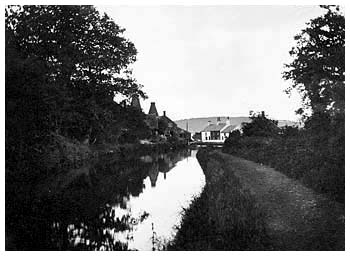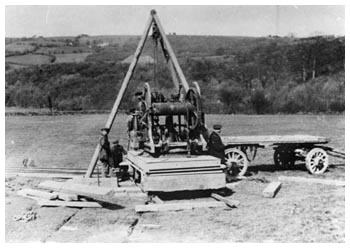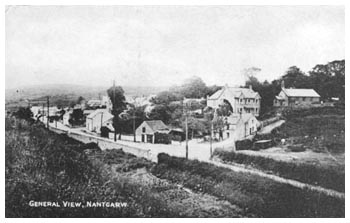
| Nantgarw | |
According to the 1841 census, about 300 people inhabited Nantgarw village and its surroundings. A significant number of them worked on the Glamorganshire Canal. Indeed Nantgarw probably owed its origin to it. The census shows that 34 of the village's inhabitants earned a living as boatmen, 16 as agricultural labourers, 15 as clay tobacco pipe makers at Nantgarw Pottery while only 11 were employed as colliers. Twenty years later, however, we gather from the 1861 census that the village's population had increased to around 500 and that the number of boatmen and colliers had almost completely reversed. This reversal was unsurprising considering the decline of the canal at the expense of the Taff Vale Railway and the opening of drift mines around the valley. |
General view of Nantgarw circa 1900 |
The start of the sinking of Nantgarw Colliery 1910 |
The 1875 Ordnance Survey map shows Nantgarw village situated between two watercourses, the Taff River to its western side and the Glamorganshire Canal to the east. When comparing it with an ordnance survey map published nearly half a century later in 1919, a striking feature is the almost complete lack of change. The watercourses running either side of the village didn't make expansion easy, but more importantly no significant coalmine was sunk nearby until Nantgarw Colliery in 1911. Therefore the village's population remained constant during the last quarter of the nineteenth century. Nantgarw village's lack of residential development continued until the Second World War. After the war a major development scheme began at Nantgarw colliery and a coke oven and by-product plant was opened in 1951. At the same time a new village settlement was built on the hillside behind the colliery. In 1969 the old village was ruthlessly destroyed when the A470 trunk road was built and today a large roundabout occupies the area where it once stood. |
| Nantgarw Pottery | |
| Nantgarw Pottery is famous for the beautiful soft paste porcelain that was made there for a short time nearly two centuries ago and which today is keenly sought by collectors. Its manufacture began when William Billingsley and his son in law Samuel Walker came to Nantgarw in 1813. It's possible that they had been in secret communication with the entrepreneur William Weston Young and that shortly before the potters arrival Young had erected two firing kilns and the necessary buildings on the eastern side of the Glamorganshire Canal. The canal's existence ensured that china clay could be brought to the works while porcelain could be transported to Cardiff for shipment to London. Adequate supplies of fuel were also nearby. Furthermore, Nantgarws' fairly remote location meant that the closely guarded skills of porcelain manufacture could be hidden from competitors. |
|
| The pottery was started with only £250 capital and experienced financial difficulties from the start. The high temperature needed to produce perfect pieces made Billingsley's soft paste method difficult to fire. At times, more than 90% of production was ruined in the firing process and was taken from the kiln damaged and unusable. Inevitably, such production losses meant that Billingsley and Walker were soon short of money. They were helped for a time by a loan of £600 from Weston Young but this was also used up without commercial success. In September 1814 Billingsley and Walker tried to secure financial assistance from the Board of Trade. |  |
| Lewis Weston Dillwyn of the Cambrian Pottery at Swansea was asked to visit Nantgarw and report on the matter. The Board of Trade failed to offer assistance and Nantgarw works closed soon after. Dillwyn invited the two potters to join him at Swansea. They began to manufacture porcelain using the Nantgarw moulds and appliances as well as continuing to impress pieces with the Nantgarw mark. It was the first time that porcelain had been manufactured at Swansea. Billingsley and Walker remained at Swansea until 1817 when they returned to Nantgarw. Despite improvement in the porcelain's quality and design, wastage in the firing remained exceptionally large. Although there was a keen demand for the porcelain from London dealers the money quickly expired and in 1819 Billingsley and Walker left Nantgarw. |
|
 |
In 1821 Young persuaded Thomas Pardoe to come from Bristol to act as manager and to assist in decorating the porcelain. It became apparent after a short time that commercial success was unattainable. In October 1822 the appliances and all the stock were sold by public auction. This marked the end of the manufacture of the famous Nantgarw porcelain. In 1833 William Pardoe, son of Thomas Pardoe, took over the vacant Nantgarw Pottery and began manufacturing glazed earthenware and stoneware. He also began manufacturing clay tobacco pipes, many of which were exported to Ireland |
Some of Nantgarw inhabitants' today recall going to the pottery as children to buy pipes with which to blow bubbles. Pipes with broken stems could be purchased for a halfpenny. After Thomas's death in 1867, the business was continued by a number of his sons under the name Pardoe Bros. The beginning of the twentieth century however saw its demise with the increase in cigarette smoking and the advent of cheaper hardware utensils. Production at Nantgarw finally ceased in 1921. During the following seventy years, undergrowth and trees enveloped the kilns and cottage. They remained hidden from view of the casual onlooker until 1991 when the Glamorgan/Gwent Archaeological Trust, supported by the Taff Ely Borough Council excavated the site. An exhibition centre opened the following year. |
|
| Nantgarw Colliery | |
| Nantgarw Colliery was one of the largest collieries in Taff Ely during the twentieth century. Sunk by Thomas Taylor of Pontypridd in May 1910, the two shafts of the colliery reached the seam at a depth of more than 850 yards making them the deepest pits to be sunk in the South Wales Coalfield up to that time. In 1924, whilst employing more than 850 men, the colliery was sold to the Taff Rhondda Navigation Steam Coal Co. The company encountered difficult geological conditions and after three years of trying to work the mine they abandoned it in 1927. It then lay idle for a while until the Powell Duffryn Steam Coal Co Ltd bought it. Following further attempts to work the pit, it was put into a 'care and maintenance' situation. In 1937, Powell Duffryn designed a development scheme to put Nantgarw Colliery back to work but this was delayed by the war. The development scheme was revived in 1946. On nationalisation of the mines in 1947, the N.C.B. took up the scheme as its first major project of the newly formed South Western Division and invested £5 million into the colliery, both on modern surface constructions and modern mining methods. |
|
| New coke ovens were opened in 1951 and production started once more in the colliery the following year. Coal was worked successfully from 1952 until 1974. Nantgarw Colliery and Windsor Colliery, Abertridwr was then combined as a single production unit. The colliery made a good recovery after the 1984/5 miners strike but failed to survive the huge closure policy of the time and closed in November 1986. Craig Yr Allt Colliery was situated south of Nantgarw village and was one of the earliest coal levels worked in the area. The Taff River, whenever it flooded, frequently entered its workings. The colliery was abandoned in 1878. |
 |
| Religion and Education | |
As with a number of Taff Ely's places of worship, St Mary's Church Nantgarw began as a schoolroom. Henry Williams, the squire of Dyffryn Ffrwd Estate, granted a piece of land to the Archdeacon of Llandaff and a school was built in 1845. The vicar of Eglwysilan was to take responsibility for religious education within the school. The building was also licensed for public worship. By 1875 the building's dual role had ended as it had ceased to function as a school. The church was renovated during the 1890s and much credit is given to Mrs Evan Williams, daughter in law of Henry Williams. She held the Sunday school at Dyffryn Ffrwd as well as a sale of work. From the 1920s onwards, however, St Mary's was to encounter problems of debt, dwindling number of worshipers and obtaining adequate clerical help. Further, the building of the A470 trunk road resulted in the demolition of the old village and the isolation of the church from the centre of population. St Mary's finally closed in 1983 and became a dwelling house. The congregation joined with St James Church Taffs Well, the church being rededicated as St Mary's and St James Church
Capel Nantgarw, the Welsh Independent Chapel was located in the centre of the old village. The original building was erected in 1825 but it was later rebuilt. Nantgarw Gospel Hall was erected in the late 1920s with second hand material. The hall remains today and members are anxious to continue to serve Nantgarw, conscious of the fact that it's the last place of worship in the village, Capel Nantgarw having been demolished when the A470 was constructed. Nantgarw Infants School opened on March 11th 1907 with 55 children on the roll. It was destroyed by fire in April 1933 and pupils were housed in Wheeler's Billiard Hall while the school was rebuilt. The school was reopened in more or less its present form on September 2nd 1935. An extension providing interior toilets, a small kitchen and an office for the head teacher was built in 1979. A similar amount of pupils are on the school's books today as when it first opened nearly a century ago. |
|

